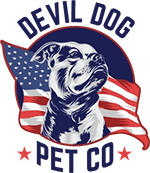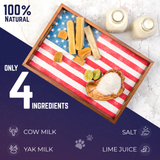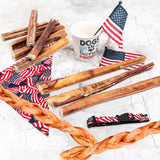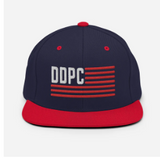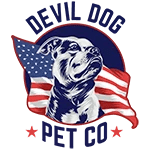Every responsible dog owner faces the same reality: your four-legged teammate needs to chew. It's not optional—it's hardwired into their DNA. The question isn't whether to provide dog chews, but which ones will keep your pup engaged, healthy, and away from your favorite shoes.
Key Takeaways
- Dog chews are designed for extended chewing and help promote dental health and mental stimulation.
- Quality dog chews last significantly longer than regular treats, ranging from 20 minutes to several weeks.
- Chewing is a natural and essential behavior for dogs, not an optional activity.
- Choosing the right dog chew keeps your pet engaged and helps prevent destructive chewing on household items.
Table of Contents
Here's the unfiltered truth: not all chews are created equal. The pet store aisles overflow with options that range from premium nutrition powerhouses to chemical-laden disasters waiting to happen. As a Marine veteran who's seen what happens when you cut corners on essential gear, I'm here to arm you with the intel you need to make the right call for your dog.
This guide cuts through the marketing fluff to deliver what matters: safety, nutrition, and real-world performance. We'll break down the difference between chews and treats, explore the benefits that actually move the needle for your dog's health, and give you the tactical knowledge to choose chews that work.
What Are Dog Chews and How Do They Differ from Treats?
Definition and Purpose
Dog chews are dense, long-lasting products that satisfy your dog's natural urge to gnaw while delivering nutritional and behavioral benefits. Think of them as the difference between a protein bar and a quick snack—chews are built for the long haul.
When our dog Dexter was younger, we learned this distinction the hard way. Standard treats disappeared in seconds, leaving him restless and searching for something—anything—to sink his teeth into. That's when we discovered that proper chews aren't just entertainment; they're essential tools for mental stimulation and dental health.
Key Differences Between Chews and Treats
-
Aspect Dog Chews Dog Treats Texture and Consistency Maintain structural integrity under sustained gnawing pressure Designed to break down quickly Duration of Engagement Can occupy aggressive chewers for weeks Provide about 30 seconds of satisfaction Functional Purpose Scrape plaque, exercise jaw muscles, mental stimulation, redirect destructive chewing behavior Primarily for training rewards or affection tokens Nutritional Density Packed with protein, minerals, and joint-supporting compounds Focus on palatability and quick reward value
Benefits of Natural Dog Chews

Based on our experience with thousands of customers and extensive research into canine nutrition, natural dog chews deliver measurable benefits that synthetic alternatives simply can't match. Here's what actually matters for your dog's wellbeing:
Physical and Mental Stimulation
Chewing triggers the release of endorphins—your dog's natural "feel good" chemicals. This isn't just pleasant; it's therapeutic. Dogs that receive appropriate chewing outlets show reduced anxiety, less destructive behavior, and improved focus during training sessions.
For high-drive breeds or working dogs, long lasting dog chew options provide the mental workout they need when physical exercise isn't enough. A tired mind is just as important as tired muscles for achieving that calm, satisfied dog we all want.
Dental Health Support
Here's where natural chews earn their keep: mechanical plaque removal. As dogs gnaw, the chew's surface acts like a natural toothbrush, scraping away soft plaque before it hardens into tartar.
- Plaque Reduction: Fibrous chews physically remove buildup from tooth surfaces
- Gum Stimulation: Chewing action promotes healthy blood flow to gum tissue
- Saliva Production: Increased saliva helps neutralize harmful bacteria
- Jaw Exercise: Regular chewing maintains strong jaw muscles and joint health
While chews aren't a replacement for regular dental care, they're a powerful ally in maintaining oral health between professional cleanings. For more on the dental benefits and risks of chews, see this veterinary guide to treats and chews.
Nutritional Value and Safety
Single-ingredient, minimally processed chews deliver nutrition your dog's body recognizes and utilizes efficiently. Compare this to manufactured treats loaded with fillers, preservatives, and artificial flavors that provide empty calories.
- High-quality protein (typically 70-85%)
- Essential minerals (calcium, phosphorus, zinc)
- Joint-supporting compounds (glucosamine, chondroitin)
- Zero artificial additives or preservatives
The digestibility factor is crucial. Quality natural chews break down safely in your dog's digestive system, while synthetic alternatives can cause blockages or digestive upset. When you're choosing healthy long lasting dog chews, ingredient transparency isn't negotiable.
"The best chews work with your dog's natural biology, not against it. Single-ingredient options like elk antlers, yak cheese, and beef pizzle provide nutrition and engagement without the chemical cocktail found in processed alternatives." - Devil Dog Pet Co. Quality Standards
Types of Natural Dog Chews
Understanding the landscape of natural chews means categorizing them by what matters most: protein source, texture, and durability. Each category serves different dogs with different needs, and the right choice depends on your dog's size, chewing intensity, and dietary requirements.
By Protein Source
-
Chew Type Examples Protein Content Best For Notes Beef-Based Chews Bully sticks, beef trachea, beef tendons 80-90% Dogs that enjoy high-protein, long-lasting chews Thick and braided bully sticks last longer Poultry Options Chicken feet, duck necks, turkey tendons Leaner protein Dogs managing weight but still need chewing satisfaction Softer than beef options Alternative Proteins Lamb, bison, rabbit, fish-based chews Varies Dogs with beef or poultry sensitivities More expensive but essential for sensitive dogs
By Form and Texture
Texture determines chewing difficulty and duration. Match texture to your dog's jaw strength and dental health for optimal safety and satisfaction.
- Hard Chews: Antlers, bones - for power chewers with strong teeth
- Medium-Hard: Yak chews, thick bully sticks - versatile for most adult dogs
- Medium: Standard bully sticks, trachea - good for moderate chewers
- Softer: Collagen sticks, thin jerky - ideal for seniors or gentle chewers
Antler and Bone Chews
Elk and deer antlers represent the longest lasting dog chews available. Naturally shed antlers provide months of chewing for aggressive chewers when sized correctly. Split antlers expose tasty marrow for dogs needing flavor motivation. Explore our full range of antler dog chews for options suited to every size and chewing style.
Himalayan Yak Chews
These traditional cheese chews from Nepal offer unique benefits: completely digestible, lactose-free after processing, and harder than most meat chews but gentler than antlers. They soften slightly with saliva, making them safer for enthusiastic chewers. Try the Beast Himalayan Dog Chew for a long-lasting, highly digestible option.
What sets yak chews apart is their "puff" feature—when the chew becomes too small, you can microwave the remaining piece to create a crunchy cheese puff, eliminating waste and choking hazards.
Bully Stick Variations
Single-ingredient beef pizzle chews come in multiple configurations to match different chewing styles and duration needs:
- Standard Straight: 6-12 inches, moderate chew time
- Braided: Three strands woven together, significantly extends duration
- Curly/Spiral: Natural shape provides varied chewing angles
- Thick vs. Thin: Thickness determines longevity more than length
How to Choose the Right Dog Chew

Choosing the wrong chew isn't just wasteful—it's potentially dangerous. Based on thousands of customer interactions and our own experience, here's the tactical approach to matching chews with dogs.
Consider Your Dog's Size, Age, and Chewing Habits
| Dog Weight | Recommended Chew Size | Duration Expectation | Best Chew Types |
|---|---|---|---|
| Under 25 lbs | Small to Medium | 1-3 hours per session | Thin bully sticks, small yak chews |
| 25-50 lbs | Medium to Large | 2-5 hours per session | Standard bully sticks, medium antlers |
| 50-80 lbs | Large to XL | 4-8 hours per session | Thick bully sticks, large yak chews |
| Over 80 lbs | XL to Monster | 6-12+ hours per session | Braided bully sticks, whole antlers |
Chewing Style Assessment
Your dog's chewing technique matters more than their size. Observe how your dog approaches chews to make the safest choice:
-
Chewer Type Chewing Style Recommended Chews Precautions Side Gnawers (Ideal) Chews from the side with back molars Harder chews like antlers Can handle tougher chews, maximize chew longevity End Biters (Caution) Chews head-on with front teeth Softer options like yak chews or bully sticks Risk of tooth damage, needs softer chews Gulpers (High Risk) Tries to swallow large pieces quickly Chews with safety features like puffed yak chews Requires supervision, risk of choking
Dietary Preferences and Allergies
Food sensitivities don't disappear when it comes to chews. Common allergens in dog chews include beef, chicken, and dairy. For dogs with confirmed allergies:
- Beef Allergies: Elk antlers, yak chews (dairy-based)
- Dairy Sensitivities: Single-ingredient bully sticks, antlers
- Multiple Proteins: Elk antlers (mineral-only) are the safest bet
Safety and Digestibility
The gold standard for safe long lasting dog chew selection involves three non-negotiable criteria:
- Single Ingredient: Avoid chews with artificial preservatives, colors, or flavor enhancers
- Appropriate Hardness: Should give slightly under firm thumbnail pressure
- Size Safety: Must be impossible to swallow whole, even when worn down
"The best chew is one that challenges your dog without risking their safety. I always tell owners: if you wouldn't feel comfortable hitting your own tooth with it, don't give it to your dog." - Veterinary dental specialist recommendation
Remember that even the best long lasting dog chews require supervision, especially during initial introduction. Every dog responds differently, and what works safely for one may not work for another. For more safety tips on chews and bones, see A Guide to Safe Bones and Chews for your Dog or Puppy.
Additional Benefits of Natural Dog Chews
Beyond basic nutrition and entertainment, healthy long lasting dog chews deliver therapeutic benefits that impact your dog's overall well-being. These advantages often justify the investment in premium natural options over cheaper alternatives.
Mental Stimulation and Stress Relief
Chewing serves as a natural stress outlet. Dogs experiencing anxiety from environmental changes, new family members, or routine disruptions benefit significantly from having appropriate chew outlets. The repetitive gnawing motion activates the parasympathetic nervous system, promoting relaxation.
For working breeds and high-energy dogs, long lasting chews for dogs provide crucial mental engagement during downtime. A German Shepherd working through a Monster elk antler exercises problem-solving skills and maintains focus—preventing destructive behaviors born from boredom.
Joint Health Support
Certain natural chews deliver functional nutrition that supports joint health and mobility. Beef trachea and cartilage-rich chews provide natural sources of glucosamine and chondroitin—compounds that support cartilage health and joint lubrication.
Advanced Dental Health Benefits
The mechanical action of chewing provides benefits beyond simple plaque removal. Different chew textures target different aspects of oral health:
- Fibrous Chews: Bully sticks create natural flossing action between teeth
- Hard Surfaces: Antlers scrape tartar from back molars where brushing often misses
- Textured Chews: Yak chews massage gums while removing soft plaque
Regular chewing also increases saliva production, which naturally buffers mouth acidity and helps control bacterial growth. This is particularly beneficial for dogs prone to dental disease or those with reduced saliva production due to medications.
Behavioral Modification Tool
Strategic chew deployment can redirect problematic behaviors. Dogs that dig, chew furniture, or engage in attention-seeking behaviors often lack appropriate outlets for their natural drives.
Shopping Tips and Product Features to Look For

The dog chew market contains both exceptional products and concerning options. Knowing what to evaluate protects your investment and your dog's health.
Transparency in Ingredients and Sourcing
Quality manufacturers provide specific sourcing information. Look for details like "grass-fed cattle from Nebraska" or "naturally shed Rocky Mountain elk antlers." This specificity indicates supply chain control and quality standards.
Ingredient transparency extends beyond the primary component. Quality chews list any processing aids, preservatives, or treatments used. Single-ingredient products with minimal processing typically offer the safest profiles.
Variety Packs and Testing Approach
Rather than committing to large quantities of untested chews, start with variety packs or single pieces. This approach helps identify your dog's preferences and tolerance levels without waste.
"I recommend customers try three different chew types before settling on favorites. Dogs' preferences can surprise you—a power chewer might prefer yak chews over antlers, or a gentle senior might love split antlers over bully sticks."
Document your dog's response to different chews: duration of interest, chewing style, any digestive changes, and wear patterns. This data guides future purchases and helps identify the most cost-effective options.
Value Assessment Beyond Price
Evaluating best long lasting dog chews requires looking beyond per-unit cost to cost-per-hour of engagement. A $15 antler that entertains for 40 hours costs $0.375 per hour. A $3 bully stick lasting 30 minutes costs $6 per hour.
- Engagement Time: Total hours of active chewing
- Safety Record: Incidents or concerns reported
- Nutritional Value: Protein content and beneficial compounds
- Waste Factor: Percentage of chew that gets consumed vs. discarded
Customer Reviews and Quality Indicators
Meaningful reviews focus on specific details rather than general satisfaction. Look for comments about chew duration, safety incidents, packaging quality, and customer service responsiveness.
Pay attention to negative reviews mentioning splintering, digestive upset, or quality inconsistency. Single incidents might be outliers, but patterns indicate systemic issues.
Brand Policies and Guarantees
Companies confident in their products offer satisfaction guarantees and responsive customer service. This backing indicates quality control standards and commitment to customer satisfaction.
Maximizing Chew Success and Safety
Having the right chew is only half the equation. Implementation strategy determines whether your investment delivers the intended benefits safely and effectively.
Proper Introduction Protocol
New chews require supervised introduction regardless of your dog's experience level. Start with 15-20 minute sessions, observing chewing technique and monitoring for any adverse reactions.
- Choose a quiet environment without distractions
- Have fresh water available
- Stay within sight and earshot
- Remove the chew if aggressive biting occurs
- Note any immediate digestive changes
Rotation and Variety Strategy
Rotating between different long lasting dog treats prevents habituation and provides varied nutritional benefits. A typical rotation might include antlers for marathon chewing, yak chews for moderate sessions, and bully sticks for high-value rewards. For a curated selection, check out our long lasting dog chews collection.
This approach also helps identify seasonal preferences—some dogs prefer harder chews in winter and softer options during hot weather when they're less motivated to work intensively.
Storage and Hygiene Practices
Proper storage extends chew life and maintains safety. Store unused chews in cool, dry conditions away from direct sunlight. Between sessions, allow chews to air dry completely before storage to prevent bacterial growth.
Clean chews periodically with warm water and a brush if they accumulate dirt or debris. Avoid soaps or chemicals that might leave residues or alter taste.
Monitoring and Replacement Guidelines
Establish clear criteria for chew retirement. Size-based rules (retire when smaller than your dog's muzzle) provide objective guidelines, but also watch for texture changes, sharp edges, or unusual wear patterns.
Making Informed Chew Decisions
Selecting the right dog chews transforms from overwhelming to straightforward when you understand your dog's specific needs and the characteristics of quality options. The investment in premium natural chews pays dividends in dental health, behavioral management, and overall well-being.
Start with your dog's chewing assessment—size, style, and sensitivity factors guide initial selections. Test different categories systematically, documenting what works and what doesn't. Build a rotation of proven winners that address different needs and situations.
Quality natural chews represent an investment in your dog's health and happiness. When chosen and implemented correctly, they provide safe, engaging enrichment that supports dental health, reduces behavioral problems, and strengthens the bond between you and your dog. Take the time to make informed decisions—your dog's well-being and your peace of mind depend on it.
Download the FREE 10-Step Dog Prep Guide
Frequently Asked Questions
What is the best chew for a dog?
The best chew depends on your dog’s size, chew style, and dental health. Whole elk antlers offer unmatched durability for power chewers, while Himalayan yak chews provide a fully edible, long-lasting option that’s gentler on teeth. Bully sticks serve as a softer, protein-rich treat ideal for puppies, seniors, or flavor-focused dogs. Rotating among these three types keeps your dog engaged and supports both mental and dental health.
What do vets recommend for dog chews?
Veterinarians typically recommend fully digestible, low-risk chews like bully sticks or vet-approved dental chews that help reduce plaque without splintering. They caution against rawhide and pig ears due to choking hazards and digestive issues. Many vets highlight the importance of supervision and selecting chew sizes appropriate to your dog’s mouth and chewing power to prevent dental fractures or choking.
What is the longest lasting dog chew?
Whole elk antlers take the crown for longevity. Their dense, mineral-rich structure withstands weeks of intermittent chewing even from tough chewers. Though pricier upfront, their cost-per-hour of enrichment beats most treats. Yak chews come next, lasting about a week, followed by bully sticks that vary widely based on size and chew intensity.
What is the best material for dogs to chew on?
Natural, minimally processed materials like shed elk antlers, yak cheese, and single-ingredient beef bully sticks rank highest. These offer a balance of durability, safety, and nutritional value without harmful chemicals or artificial preservatives. Avoid synthetic or chemically treated chews that can splinter or cause digestive upset.
What is the healthiest thing for a dog to chew?
Healthy chews promote dental health, mental stimulation, and safe digestion. Elk antlers provide minerals like calcium and zinc while scraping plaque; yak chews stimulate saliva and are lactose-free; bully sticks offer digestible protein. All support good jaw exercise when sized correctly and given with supervision, making them top choices for health-conscious owners.
Are pig ears safe for dogs to chew on?
Pig ears pose significant risks despite their popularity. They can be high in fat, leading to pancreatitis in sensitive dogs, and are often contaminated with bacteria causing digestive upset or infections. Additionally, their chewy texture can cause choking or blockages. Most vets and responsible owners steer clear, opting instead for safer, vet-approved chews like bully sticks or antlers.
